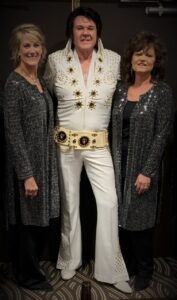Labor of love
By Staff
Rodgers honored for devotion to Hurricane Creek
Clif Knight, Hartselle Enquirer
A love affair with nature is the thread that weaves the awe-inspiring story of Hartselle's William "Buddy" Rodgers and his 43-year marriage with Hurricane Creek Park in Cullman County, as its founder, engineer, builder, owner, operator and caretaker.
The 84-year-old World War II hero parted company with the popular 80-acre tourist attraction in 2003 because of declining health. Thanks to his generosity, Forever Wild of Alabama was granted ownership as a gift and the city of Cullman became the keeper of the gate.
Rodgers now lives in Hartselle with his sister, Frances Rodgers. They occupy their family's historic white frame house on North Sparkman Street.
The park was dedicated in Rodger's honor and renamed "Buddy Rodgers Natural Resource Reserve" in April 2003. Some improvements have since been made mainly to ensure the safety of visitors but nothing is planned that would take away from the natural beauty of the landscape.
Rodgers will be the honoree at a "Friends of 'Buddy' Rodgers Picnic" at the park on Saturday, Oct. 15, from 9 a.m. to 5 p.m. The public is invited free of charge. The picnic area will be open to those who wish to bring a basket lunch and grilled hot dogs and soft drinks will be available.
"I loved the park and I was happy there," Rodgers stated. "I got a lot of satisfaction from building something for others to enjoy. Now I'm pleased that it's in the hands of someone whose commitment is to preserve its natural beauty."
Rodgers was first introduced to the park site in 1958 while flying a reconnaissance mission for the Alabama Air National Guard.
"I was photographing an area from Birmingham to the Tennessee state line," he recalled. "A deep gorge with steep cliffs and a clear stream caught my eye as I flew over Vinemont. I had been stationed at Lowery AFB in Denver, Colo. earlier and had opportunities to see the Rocky Mountains from the air. They were magnificent but I was just as impressed with what I'd seen less than 20 miles from my hometown. I could hardly wait until I could take a look at ground level.
Rodgers was even more awestruck when he drove to the gorge later and climbed down the 200-ft. north bank to look around.
"I spent half a day there trying to take in everything I was seeing. When I left I was committed to buying the land and fixing it up so others could enjoy its beauty," he said.
Three property owners were involved and it took Rodgers several months to strike a deal with all three.
It took nearly two years for him to get the park ready for visitors. An office building was contracted out but most of the other work…two walking trails, swinging bridges, creek crossings, stairway and cable car track…he did himself.
"It was a lot of hard work and most of it was done with a pick, shovel and sledge hammer," Rodgers stated. "I took it one step at a time. I'd work on one thing until it was done and then move on to something else."
Twilit Cave was a project that tried Rodgers patience and physical stamina to the limit. He discovered the 600-ft. earthquake split in the rocks by lowering himself through a small opening above. He found the crevice filled with tons and tons of dirt and rocks. He worked in and out of the opening, removing the fill a bucketful at a time. It took him all winter to reach the natural entrance to the cave.
Rodgers kept the park open from sunup to sundown seven days a week, including holidays. Admission in the early days was 75 cents for adults and 50 cents for children. Later, it was increased to $2.50 for adults and $2.00 for children.
The only time we closed was when ice was on the ground and it wasn't safe to use the steps or trails," he said. "We never got anybody hurt seriously. I'm real proud of that."
Visitors came from all over the country and a lot of them were repeat customers. Weekends were the busiest time and 150 to 200 people was considered a good day.
Rodgers operated the park most of the time by himself. In the latter years he lived in an apartment above the office. He also took care of all of the upkeep and maintenance.
"I would make repairs and do other maintenance work during the slow times," he pointed out.
Rodgers said spring was his favorite time of the year to be in the park. "That's when the creek is running full and the waterfalls are at their peak, the foliage is bursting out on the trees, the mountain flowers are blooming and the birds are flitting about and singing to each other," he added.
When Rodgers started his park project he had already served nearly 20 years in the U.S. Force. He joined the U.S. Army Air Corps in 1940 as a private and earned a commission and his pilot's wings after completing flight school as a buck sergeant. As a pilot with the 365th Fighter Bomber Group based in England, he flew 120 combat missions in the European Theater. On one of the missions he carried Edward R. Marrow, a well-known radio broadcaster and war correspondent, as a passenger. The report Marrow brought back from the flight over enemy lines captured worldwide attention.
"My commanding officer singled me out to fly him (Marrow) after he requested a pilot that would show him some excitement," acknowledged Rodgers. "They fixed a seat in the cockpit of my P-47 and we took off for Reamer Bridgehead. We didn't encounter a lot of resistance and after awhile I told him I though we ought to get out while the getting was good. He wanted to go back and take another look at the target area That's when we started getting gunfire from all directions. Fortunately, we were able to get out within being hit."
Rodgers went on to serve in the Air Force for 21 years and the Alabama National Guard for nine years. He was decorated with the Silver Star, Distinguished Flying Cross, Air Medal with 12 clusters and 19 bronze oak leaf clusters.
After World War II Rodgers operated a taxi cab company. He also served on the city council.








